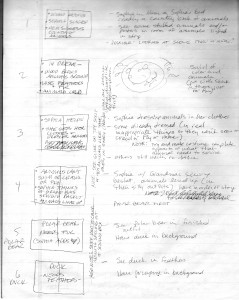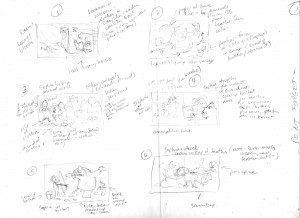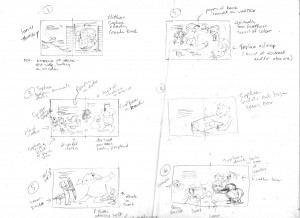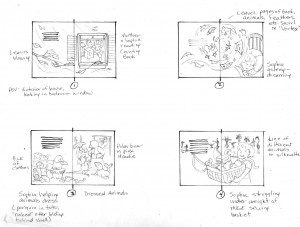Well, technically, i guess it really starts with the publisher contacting you to see if you’d like to illustrate another book… then after much clamor and excitement and jumping up and down and e-mailing back “YES!” in big bold letters you sit back and wait for the manuscript to be forwarded. For me this all happened in the Spring of 2009 (April 2 to be exact) when i got the initial e-mail asking if i’d be interested in illustrating “Fur and Feathers” and noting all the business and deadline particulars, but i must admit i was chewing my nails for those first couple months of the year waiting to hear if i’d have a new title to do.
I can’t speak for all artists but i am very insecure when it comes to work and always fear every finished project will be my last. “Where Should Turtle Be?” had just come out mid-February or so, and Sylvan Dell was busy getting their other Spring titles on the shelves, so i didn’t want to nag them about whether they had a new book for me to illustrate – but i was eager to start on a new illustration project. I attempted to be calm and philosophical while i waited, figuring if SD didn’t have anything for me this time around i could take the lull and work on one of my own personal book projects (i have notebooks full of plot ideas and character descriptions and snippets of dialogue, so have plenty to keep me busy if i could ever get serious about finishing something) but then i got the notice about the new book so immediately put all my own things back on the shelf. I’m not giving up on writing and illustrating one of my own stories one day, but i’m content to wait until the Creative Writing Muse can give me her full attention. And basically, i just work better when i have a firm deadline (otherwise i tend to be like Dug, the dog in “Up”, easily distracted by…. “Squirrel!“).
So… where was i? Oh yes, The Manuscript. “Fur and Feathers” was written by the very talented Janet Halfmann, author of many children’s books as well as my 2nd children’s book for Sylvan Dell, “Little Skink’s Tail”. “Skink” was a fun book to illustrate, and seems to go over particularly well at school talks, so i was excited about working with Janet again. Tho i think i should clarify what i mean by work with her. I actually don’t work with her directly at all, all my correspondence and art direction comes from Sylvan Dell. I don’t know how other publishers work, but i suspect it is all pretty similar – an author writes a story and submits it and then waits until, several months down the road, they finally get to see what a complete stranger did with their words. I suspect it can be a little scary. It would be fascinating to get Janet’s perspective on the process because i really don’t know what it must be like to write something and send it off and not see the story that you slaved over again until someone else has visually interpreted it. Obviously there needs to be a great deal of trust between the author and her publisher, and the publisher and their artists, and i can assure Janet (and any/all authors whose books i’ve had the pleasure and privilege to illustrate) i treat every one with the utmost respect and care. And F&F was a particularly fun and challenging story to work on.
The manuscript was e-mailed, with the story already separated by page (what words were to go where), and being a children’s picture book that meant every full-page spread counted as one illustration so the drawings had to fit the action described. I always approach every book (and most other art projects) the same way – just sitting back and reading the story and jotting notes on a legal pad.
Often it’s all just written notes and impressions. The box on the left represents the full-page spread with the key elements of the narrative written inside. Off to the right i make illustration notes. Most of the time, at this stage, i don’t actually draw anything, but some times a visual image will immediately come to mind (like the swirly vortex on page 2) and i’ll sketch it in (particularly if it’s too hard to explain verbally).
After that i tend to go off on a reference hunt – any excuse to go to all my favorite bookstores to get books on the various characters, actions or settings of the story. In this case, several different animals were going to be hi-lighted (a polar bear, a duck, a porcupine, a frog, a fish, a snake, a snail, and a ladybug) not to mention the story centered around a little girl, with all the action taking place in her bedroom, so i had a great time looking for books on everything from animals to girl’s clothes to bedroom design. I have walls of bookshelves so already have a pretty vast source of references but one can never have too many books!
The next step is taking my written notes and roughing out the proposed illustrations in a series of small thumbnail sketches (NOTE: I don’t expect you to actually see these very clearly, this is more to simply give the idea of the steps involved).
As the name suggests – these sketches are real small, only a couple inches wide – so i obviously don’t worry too much about detail or perspective or even where the words are going to go during this phase, this is just a way to start roughing in the layout. It’s probably one of the hardest steps in the process because i’m staring at a blank page and trying to fill it. I much prefer the next stages – when i can start fine-tuning the sketches.
It may not look significantly different from the first batch of thumbnail sketches, but at this stage i start figuring out where the type is going to go and what my “live” area will be. I really enjoy the editing process – whether it’s drawing or writing – and this is when i get to fine-tune the details. Then it’s on to the last stage of the thumbnail process.
It’s all still rough, and each sketch still only a couple inches wide, but it’s enough to get the basic idea of what each full-page spread of the book will look like. I suppose another term for it could be “storyboard”. It’s the last step before i enlarge the rough sketches up to book size so i like to send these finished thumbnails to the publisher’s Art Director and Editor for their input. It is not an official contractual deadline (which usually consists of: Rough Sketches, Finished Cover Art, and Final Color Art) but i feel more comfortable having them see the direction i intend to go, just in case they have some concerns or alternative suggestions.
If they like the thumbnails… then it’s on to the Pencil Roughs.




Laurie, these posts on your art process are so fascinating. Picture books truly are the blending of many creative minds!